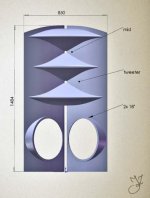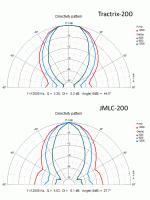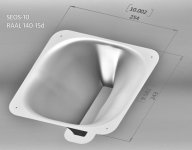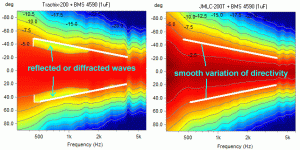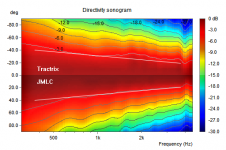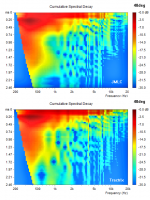I have the Stereolab 400 and bought the JMLC 350 , do I made and error? Sure the JMLC should generate much less HOM. I will try them with a GPA 288 and report in a few months.Correct and Tractrix is almost two times smaller.
chris
Hello:
Is it still possible to add orders to the group buys? How and at what point do you take payment? May I ask for leadtime as currently envisaged.
As for adapters, for example to go from 2" to 1.5", do you continue the profile?
Regards
Rakesh
Is it still possible to add orders to the group buys? How and at what point do you take payment? May I ask for leadtime as currently envisaged.
As for adapters, for example to go from 2" to 1.5", do you continue the profile?
Regards
Rakesh
Pellet has been sent already (next uknown) - we organize website: DIY Sound Group
Profile can be continued but for such a short adapter IMHO better extend duct in the driver.
Profile can be continued but for such a short adapter IMHO better extend duct in the driver.
Attachments
yea sine me up for ever is good please drop me a line if another group buy is happening specially OS W bigger the better
OMG OMG OMG I cant believe what I seeing and I can afford them! I have seen god in a horn. Months looking for horns ,looking at plans wasted. Untill now. The E-JMLC omg omg its a dream come true. I cant believe I just bought a pair of jabos. I will use them for flower pots. Now I want a E-JMLC 200hz I goter have them! Who have I got to kill? Does it sound as good as it looks like it would. I want JMLC magic with wider Horizontal. Can it do it? I goter go loook more
lol yea I was manic yesterday. No sleep. Yea it would be too big to ship to me. I have a pair of azura. Would love some extensions to continue the flare down to 2 inch.
Member
Joined 2003
Jack,
What measurement distance do you use? Distance to throat or mouth?
From mouth 80-100cm (30-40 inches) when in room, BK4149 with 2610 amp.
Hottest projects in summer 2011: OB and WG for dipole RAAL 140-15d.
I don't see the value in using the same size horn for the tweeter.....
Do I interpret it right? The Tractrix is the smoothest, the Miniphase is the less directional although not so smooth and the JMLC is very directional (beams)?
Chris
No I don't think that is right. Compare the -5db contours for both the tractrix and the JMLC and you will see that the tractrix has a much narrower beamwidth at higher freq than the JMLC, which is to say the tractrix beams more. Its rate of change of beamwidth is a little slower however, but its coverage is narrower.
To joshK, this time I looked carefully. Both have about the same coverage up to 10 kHz then JMLC narrows quicker.
I then have another question: what does it mean that the JMLC has strong 2.5 dB contour and Tractrix don’t have it at all? different efficiency of the horns? JMLC would play louder on axis ?
Chris
I then have another question: what does it mean that the JMLC has strong 2.5 dB contour and Tractrix don’t have it at all? different efficiency of the horns? JMLC would play louder on axis ?
Chris
Hello Jack
About the way to analyse the directivity maps you obtained from your measurements, my own views will differ somewhat of yours.
I took your maps for both the 200Hz Tractrix and the 200Hz Le Cléac'h horn and removed the frequency above 4500Hz as the response in that range is due to the tweeter part of the coaxial BMS driver which one possess a diameter much smaller than the throat diameter of the horn.
Between 450Hz and 4000Hz I draw two straight lines (white color) passing through the -5dB limits of the polar map of the Le CLéac'h horn and reproduce the same 2 lines on the polar map of the tractrix.
Your polar map for the 200Hz Le Cléac'h horn is consistent with the FEA simulation performed by John Sheerin which one indicate a very smooth variation of the directivity with the frequency (very few refelctions and HOMs inside the horn).
http://ldsg.snippets.org/HORNS/images/polarmaps/LeCleach_275_flat_wave.jpg
As we can see on the attached graph is that the directivity of the 200Hz Le Cleac'h is equal or smaller than the one of the Tractrix from 450Hz to 4000Hz.
From 400Hz to 1800Hz the -5dB line fro the the tractrix deviate from the white reference lines and I enlightened the zone comprised between the -5dB line and the white lines. On that frequency interval the directivity is more larger for the Tractrix (more beaming in that frequency range). I intrepret that zone as the result of backreflected, reflected or diffracted waves interfering with the direct wave. This should be probably attenuated if the tractrix horn was included at its mouth to a large planar baffle.
You polar map for the 200Hz tractrix is less consistent with John Sheerin's simulation of a tractrix horn. Most probably the reason is because in John Sheerin's simulation the tractrix horn is inserted in an infinite baffle.
http://ldsg.snippets.org/HORNS/images/polarmaps/tractrix_275_flat_wave.jpg
Best regards from Paris, France
Jean-Michel Le Cléac'h
Correct and Tractrix is almost two times smaller.
About the way to analyse the directivity maps you obtained from your measurements, my own views will differ somewhat of yours.
I took your maps for both the 200Hz Tractrix and the 200Hz Le Cléac'h horn and removed the frequency above 4500Hz as the response in that range is due to the tweeter part of the coaxial BMS driver which one possess a diameter much smaller than the throat diameter of the horn.
Between 450Hz and 4000Hz I draw two straight lines (white color) passing through the -5dB limits of the polar map of the Le CLéac'h horn and reproduce the same 2 lines on the polar map of the tractrix.
Your polar map for the 200Hz Le Cléac'h horn is consistent with the FEA simulation performed by John Sheerin which one indicate a very smooth variation of the directivity with the frequency (very few refelctions and HOMs inside the horn).
http://ldsg.snippets.org/HORNS/images/polarmaps/LeCleach_275_flat_wave.jpg
As we can see on the attached graph is that the directivity of the 200Hz Le Cleac'h is equal or smaller than the one of the Tractrix from 450Hz to 4000Hz.
From 400Hz to 1800Hz the -5dB line fro the the tractrix deviate from the white reference lines and I enlightened the zone comprised between the -5dB line and the white lines. On that frequency interval the directivity is more larger for the Tractrix (more beaming in that frequency range). I intrepret that zone as the result of backreflected, reflected or diffracted waves interfering with the direct wave. This should be probably attenuated if the tractrix horn was included at its mouth to a large planar baffle.
You polar map for the 200Hz tractrix is less consistent with John Sheerin's simulation of a tractrix horn. Most probably the reason is because in John Sheerin's simulation the tractrix horn is inserted in an infinite baffle.
http://ldsg.snippets.org/HORNS/images/polarmaps/tractrix_275_flat_wave.jpg
Best regards from Paris, France
Jean-Michel Le Cléac'h
Attachments
Last edited:
- Home
- Group Buys
- Waveguides and horns


